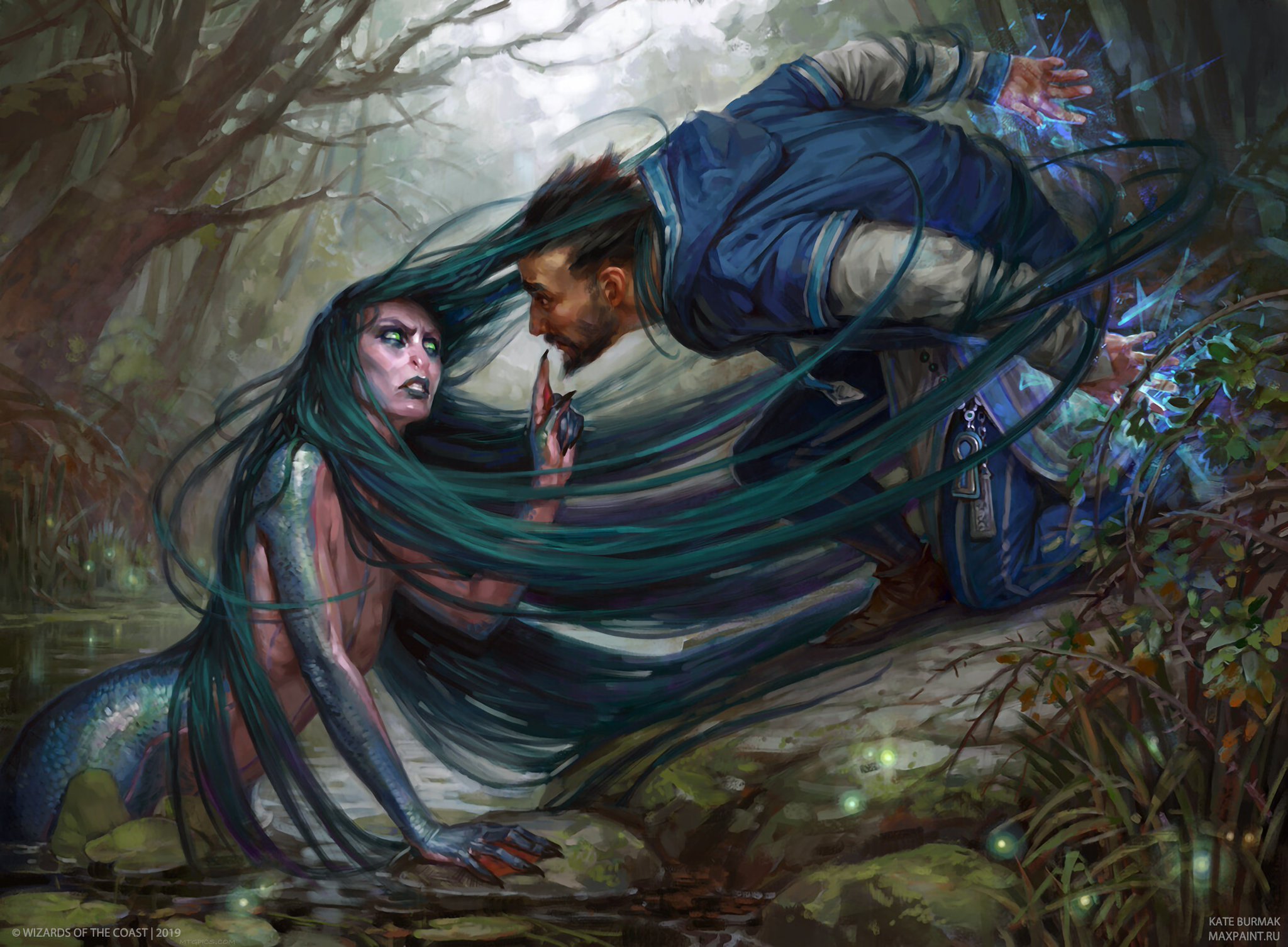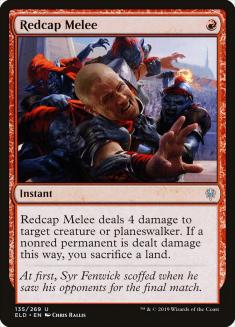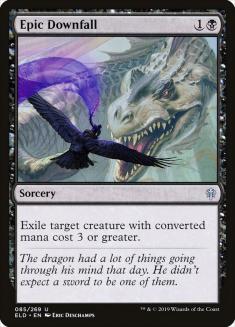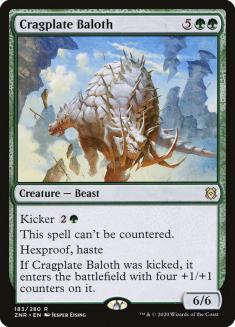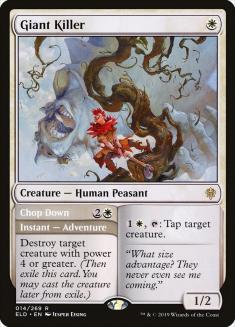Historically, Week 1 of Standard after rotation has been a bit of a crapshoot. There are cards being hyped and decks that are mostly intact from the previous season, but until the cards hit the table, it’s too hard to figure out exactly how the matchups will play out and which cards will over or underperform.
With this level of unpredictability, building sideboards early on was always impossible, because you didn’t know exactly what you’d be playing against. You’d be forced to sideboard in generic ways, including some sort of cheap removal spell for aggro, a planeswalker or sticky threat for removal-heavy decks, and maybe a Disenchant or two for good measure. Whether the exact tools you included would prove relevant was just a part of the Week 1 lottery. This uncertainty is a huge part of aggro’s success in these events, since you’d often catch players without the right tools and run them over, only for them to adapt the following week now that they had you in their sights.
This dynamic has largely gone away since the introduction of Magic Arena. Sets are now released online a full week before major tournaments are played, leaving the community time to play millions of matches and for a loose metagame to form around strategies that prove powerful and/or gain hype on social media over that week.
On one hand, I don’t like having some of the mystery spoiled before that first event — it kills some of the excitement. But on the other, having a semblance of a metagame helps with sideboarding a lot. There are a few decks floating out there that should be popular this weekend, and preparing for those is going to greatly increase your chances for success.
Based on what I expect this weekend, I’ve isolated a card from each color that you should be playing so long as it fits your strategy.
Red — Redcap Melee
This one is already starting to pick up, and you don’t want to be left behind. Last season, Redcap Melee was a great card against Mono-Red Aggro and Winota, Joiner of Forces but that was about it. If you expected Torbran, Thane of Red Fell and friends, then you might pack a copy or two, but otherwise it didn’t do much. But with Omnath, Locus of Creation set to be the next bogeyman, Redcap Melee’s stock is skyrocketing.
Omnath has seen play in pure ramp strategies as well as more interactive control decks that can still leverage the extra mana to bury their opponents early. Omnath does everything so its potential homes are only limited by your ability to cast it. Heck, I’ve even seen it in a list next to Winota!
These decks are great at taking over the long game, so closing speed is important. Redcap Melee helps a ton by answering their four-mana creature at a 75% discount. But the rise of these decks have done even more to help Redcap Melee’s standing in the metagame.
The ubiquity of Lotus Cobra has brought the number of Bonecrusher Giants way up. It’s the best way to interact with an early Cobra, is among the best anti-aggro cards in the format, and trades with Omnath in combat. With its presence in non-Omnath decks, it’s perhaps the most-played nonland card in the format right now.
And finally, the ramp-heavy Omnath decks often top out at Genesis Ultimatum, which comes with Terror of the Peaks as a way to allow Ultimatum to immediately interact with opposing creatures. I’ll gladly turn my Redcap Melee into a Dismember to answer their five-mana creature.
There are more targets beyond these, with Gruul Aggro and the carryovers from last season, but the sum total is that Redcap Melee is the best sideboard removal spell in the format, and I wouldn’t leave home without at least three copies in any red deck. I see two copies in a lot of lists still, which I’m assuming due to inertia from last season. Don’t be one of those people.
Blue — Mystical Dispute
Okay, this one shouldn’t be a big surprise, but I think a lot of players are going to lean on another blue card as their all-star sideboard card: Confounding Conundrum. It looks tailor-made by Wizards of the Coast (WotC) to check the powerful ramp cards in the metagame, and as a cantrip it does so at a low cost.
The problem is that it doesn’t actually stop them from playing normal Magic. Nor does it prevent them from going berserk on a single turn. It just costs them a land drop or two to do so. And as the game goes long, they can even use it to their advantage, returning a modal double-faced card (DFC) they played earlier as a land to their hand, thus effectively drawing a card.
Unless you’re taking advantage of Confounding Conundrum in another way, say with Yorion, Sky Nomad, I’d stay away. Effective hate cards have a much more disruptive impact on the opponent’s gameplan. Conundrum is more of a mild inconvenience.
Mystical Dispute, however, is as great as ever. Countering an early Omnath is a great exchange, and against their best draws, you can undo the big payoff in Genesis Ultimatum. You’ll want to have significant pressure if you plan on playing a ton of copies, since they’ll eventually be able to play the three, but pressure plus disruption is a great plan against ramp strategies, so that shouldn’t be a big ask.
Unless you’re taking advantage of Confounding Conundrum in another way, say with Yorion, Sky Nomad, I’d stay away.
Moreover, there are plenty of Dimir Rogues decks floating around, and while I’m not high on them long-term, I would expect to run into one this weekend. It’s not a particularly powerful strategy, but it can easily get underneath and run you over if you don’t respect it, so having a one-mana card that trades with a creature or Drown in the Loch is a great way to keep the pressure off long enough for your more powerful spells to take over.
When a new set is released, there’s a temptation to play with the shiny new toy, but in this case it’s old reliable that will get the job done.
Black — Epic Downfall
Heartless Act is the gold standard for black removal right now, since it cleanly answers all the major threats aside from a late-game Scavenging Ooze. Bloodchief’s Thirst is poised to play a major role in these decks too. But black decks are always looking for more removal, and I’m seeing a lot of Eliminates next to these two when I think Epic Downfall is much better.
Uro, Titan of Nature’s Wrath is going to be a problem for another year, and unless you’re ending the game early, having some way to exile it is quite valuable. Epic Downfall was used in this role last season, but played awkwardly since it didn’t actually answer Hydroid Krasis. With Krasis gone and Omnath in the metagame, Epic Downfall should be live much more often.
Since Epic Downfall is a sorcery with a significant restriction, you won’t want to play that many copies, especially in aggressive decks, but one or two will go a long way against the Uro decks of the world. Keep in mind that when you’re building a removal suite, you need to look at the holes that your primary options have, and use the remaining slots to fill those holes. Eliminate is a significantly better card than Epic Downfall in a vacuum, but it’s unnecessary in a world without Hydroid Krasis; Teferi, Time Raveler; and Narset, Parter of Veils.
Green — Cragplate Baloth
Of the five cards on this list, this is the one I’m least confident in, because it requires a metagame development that I’ve yet to see but I expect to come. That metagame development is the emergence of a true control deck.
Typically, players shy away from control on Week 1, but as I noted above, we live in a different world now, and with a week to monitor the metagame and tune their lists, I think there’s room for control to compete this weekend. Exactly how Shaheen Soorani will do that, he has yet to tell me, but I’m sure he’s hard at work in his laboratory.
As constructed, these Four-Color Ramp decks look vulnerable to Neutralize and friends, but they can do a lot of damage with Cragplate Baloth, which is reminiscent of former sideboard staple Gaea’s Revenge.
There will be games where Cragplate Baloth embarrasses their hand full of Mystical Disputes, Neutralizes, and Elspeth Conquers Deaths, and that’s the ideal, but there’s another tactic available to these Omnath decks that makes the Baloth valuable: they can use it as a one- or two-shot finisher.
Control players have to use their life total as a resource in order to set up favorable exchanges, confident in their ability to take over the game to the point where their low life total is irrelevant. On top of this, Lotus Cobra, Omnath, and other creatures provide a lot of incidental damage, especially if you can triple-trigger the Omnath. Against sweepers like Shatter the Sky and Extinction Event, you can play more aggressively, put your opponent into a situation where they can gain significant value by tapping out, and then punish them with a Baloth that ends the game before they can find a backup sweeper.
You won’t want Baloth in any Uro mirror, but against the Azorius and Dimir players of the world, it’s a haymaker that punishes them for holding up a counterspell when you’re set up to cast Genesis Ultimatum or tapping out for a sweeper. If control doesn’t materialize this weekend, then it could be a dud, but if I were playing Omnath or any other midrange green strategy, I’d be deathly afraid of Neutralize decks, and I think you can afford a slot or two to help against them.
White — Giant Killer
Full disclosure: I’ve spent the last weekend desperately throwing every aggro deck I can think of against the Omnath menace to see if I can get something to stick. So far the results have been mixed at best, but every day I’m learning bits and pieces of how to properly attack in this metagame and I’m hoping to piece all of that together into a functioning decklist.
One of the lessons I’ve learned is that aggro decks need to walk a fine line between not having enough removal to answer the many powerful threats that are seeing play and not having enough threats yourself to end the game before you run out of removal. This is particularly difficult for white decks that have weaker removal options than red, black, and even green.
Giant Killer has been great for me in these decks, since it’s a cheap creature that accepts counters from Luminarch Aspirant or an Equipment like Maul of the Skyclaves so you can put on that early pressure that’s so important, while transitioning into creature removal later in the game, helping your cheaper creatures get through Omnaths and Elder Gargaroths. If you draw it later, you net a clean two-for-one with Chop Down.
My white decks have tended to be more linear than other aggro decks, and being able to transition into a more interactive configuration without sacrificing curve or creature density is important. But I would also look to Giant Killer out of slower decks, because the most successful aggro decks last weekend were Gruul.
Gruul means big creatures and Embercleave, so every way to keep Lovestruck Beast and Questing Beast out of combat is valuable. Giant Killer isn’t the best against Mono-Red, but it’s still a one-drop that checks Fervent Champion and trades for Rimrock Knight. Later on it can tap down Anax, Hardened in the Forge to stop similar Embercleave shenanigans.
Week 1 Is Underway
Week 1 is often about figuring out which cards live up to the hype and which cards fall flat. But it’s still a weekend of Magic tournaments just like any other. And that means you should still be building and tuning with a specific metagame in mind as much as possible.
That can be hard when you’re so focused on trying out the new cards and learning as much as you can about how to play with and against them, but in Magic, the little things are important. Don’t neglect your sideboards just because there is more uncertainty this weekend.

